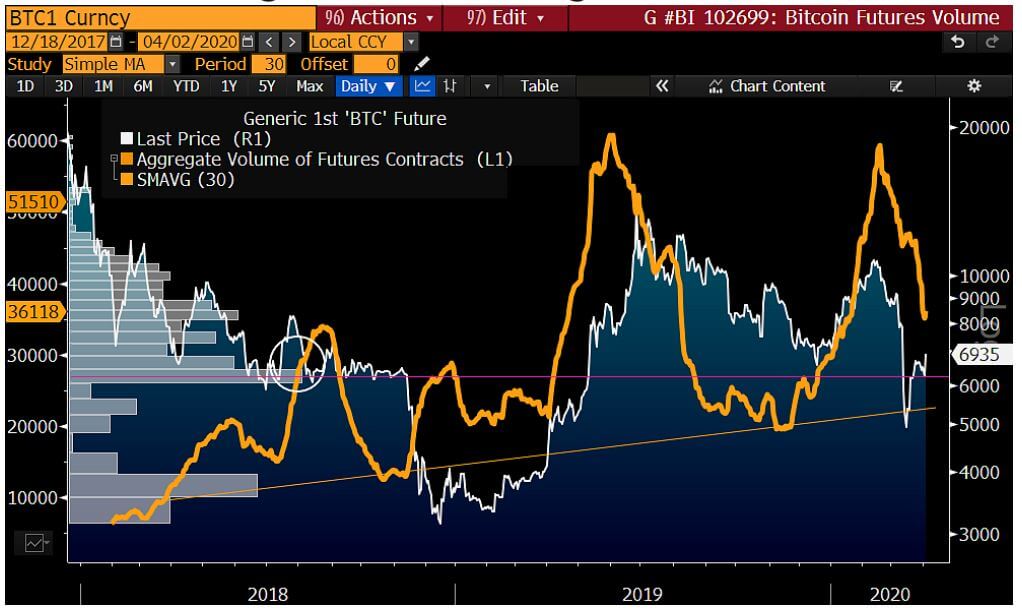 Even after the 50% crash, this Bloomberg analyst thinks Bitcoin is bullish: here’s why
Even after the 50% crash, this Bloomberg analyst thinks Bitcoin is bullish: here’s why Even after the 50% crash, this Bloomberg analyst thinks Bitcoin is bullish: here’s why

Cover art/illustration via CryptoSlate. Image includes combined content which may include AI-generated content.
It would be fair to say that Bitcoin didn’t perform too well in March. For those who have been living under a rock, the cryptocurrency shed more than 50 percent of its value on Mar. 12 and 13, plunging from a price just shy of $8,000 to lows at $3,800 in a dramatic fashion, liquidating over $1 billion worth of long positions in the process.
Even after the recent recovery we’ve seen, Bitcoin remains 51 percent lower than the $13,800 high seen at the end of June in 2019, which many thought would kickstart the next parabolic growth phase for our favorite orange coin.
With that in mind, the obvious answer to the question “Is Bitcoin in a bull or bear market?” is seemingly the latter, the bear market option.
Though, according to a top Bloomberg analyst, Mike McGlone of the commodities desk, the asset is actually in a “consolidating bull market” rather than a full-blown bear market, similar to the one seen in 2018.
Here are four reasons why he thinks so.
Reason #1: Growing futures volume & options trading suggests “more mainstream adoption”
Despite the recent decline in volumes seen in the Bitcoin futures market, McGlone suggested that the “advent of listed futures” and options trading, which have been adopted as evident by the open interest and volume metrics, are “key for the nascent digital asset with limited supply.”
He added that due to the nature of futures, these derivatives are likely to “pressuring volatility [lower]” while “buoying prices,” as the increased demand for the scarce asset is likely to increase its price just going off simple supply-demand dynamics. As McGlone wrote:
“Limited supply points to demand and adoption as the primary price determinants for the benchmark crypto.”
Furthermore, with the Bitcoin price stabilizing at the 30-day average of the futures volume (Bloomberg data), McGlone’s desk believes the asset remains in a “consolidating bull market,” presumably citing the oft-held sentiment that consolidation precedes expansion.

Reason #2: Bitcoin on-chain indicators remain “price supportive”
Corroborating the broader narrative of increased adoption, Bloomberg observed that the on-chain metrics of the Bitcoin network remain “price supportive,” despite the coronavirus outbreak. The outlet wrote:
“Bitcoin appears to be discounted vs. its primary on-chain indicators. Representing adoption, the 30-day average of active addresses has stabilized closer to $9,000 vs. about $6,600 on April 2.”
McGlone elaborated that with increasing adoption, Bitcoin is starting a transition process to become a “digital version of gold.”
Notably, CryptoSlate’s analysis found that there is similar strength on the side of Ethereum, which has also seen some strong on-chain metric readings over recent days.

Reason #3: Crypto is outperforming equities from a quarterly perspective, showing “divergent strength”
McGlone then highlighted the fact that Bitcoin (and gold) is actually outperforming equities and other traditional assets from a quarterly perspective, which suggests they are on the “back ends of a significant shakeout.”
They added that with Bitcoin down only about “5 percent in 2020 vs. almost 22 percent for the S&P 500,” they’re starting to see the cryptocurrency is in the midst of “diverging strength,” indicating of a move towards “gold-like adoption, maturity, and performance.”
Reason #4: Macroeconomic conditions favor gold
All these mentions of Bitcoin becoming a gold-like asset are important, for one of the key narrative underpinning the Bloomberg report is that the macroeconomic conditions are favoring the precious metal, and should thus benefit BTC too.
As CryptoSlate has detailed heavily over the past few weeks, negative interest rates and the so-called “QE infinity” policy on behalf of the Federal Reserve are two macro factors that are likely to benefit scarce assets.
Indeed, the analyst wrote that with monetary factors trending towards debasement and a potential devaluing of the world’s reserve currencies, his desk sees gold extending towards its all-time high of $1,900.
This, in turn, could benefit Bitcoin, which Bloomberg confirmed is starting to correlate with the precious metal.
Indeed, Dan Morehead — founder of blockchain-focused fund Pantera Capital — wrote in a newsletter published late last month that monetary policy is likely to allow Bitcoin to set a new record above $20,000 in the coming 12 months:
“As governments increase the quantity of paper money, it takes more pieces of paper money to buy things that have fixed quantities, like stocks and real estate, above where they would settle absent an increase in the amount of money. The corollary is they’ll also inflate the price of other things, like gold, bitcoin, and other cryptocurrencies.”






















































